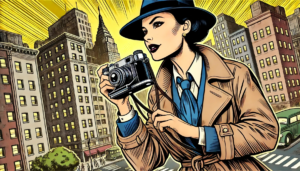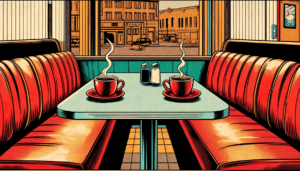"So, Tell Me About Yourself."
I hate it when someone says that. Seriously. I mean, what’s the expectation here? Do they want to know about my life from birth to present day? (Doubt it.) Or do they just want to hear about small slices of my life — like what I do for a living or what my hobbies are or whether I’m more of a dog person or cat person? (For the record, I’m both.)
In most cases, when someone asks you to tell them about yourself, it’s within a specific context and they’re looking for specific information. For example, if you’re in a job interview, they’re probably asking so they can hear more about your professional experience. If you’re asked during a first date, it’s a conversation starter that usually leads to a response of, “Well, what do you want to know?” The details you offer about yourself will depend on what the situation is and who’s doing the asking. The same is true for your business’s brand story.
There’s a tendency to think that your business’s brand story should be one huge, sweeping epic. Think Dances with Wolves or 2001: A Space Odyssey or Saving Private Ryan. We’re talking blockbuster status here.
But I disagree — at least in the sense of how we might think about the concept of a brand story. Instead of looking at it as one long, comprehensive story that tells EVERYTHING about your business EVERY TIME in EVERY SITUATION, what if we looked at it as a “chapter book.” The only difference being is that we can shift the chapters around when we need to without changing the story’s overarching theme.
Instead of looking at your brand story as one long, comprehensive story that tells EVERYTHING about your business EVERY TIME in EVERY SITUATION, what if we looked at it as a “chapter book?”
Michele Lashley, The Story Sandbox Tweet
Your Brand Story—Chapter by Chapter
Just like in the example we started out with a few paragraphs ago, different people with different needs are going to have questions about your business in different situations.
For example, let’s say you’re talking to a potential customer who asks you how your business is uniquely positioned to solve a particular problem. In this case, she doesn’t want to hear about how you started your business in the garage with only $200 in seed money from your parents. That’s the “where it all began” part of your brand story and it has nothing to do with what the potential customer is asking you — unless she’s wondering how to start a business in her garage with $200 in seed money from her parents.
Instead, what you’d want to lead with in an interaction with this potential customer is the part of your brand story that focuses on how you’re different than competitors. AND you’d want to explain how your solution is the BEST option for successfully addressing the challenge the potential customer is facing.
When you create a brand story that can easily be broken up into chapters, it becomes a much more powerful marketing tool. Each chapter incorporates the spirit of the mission, vision and values of the company — but each also has a different and very specific focus.
So, what are the chapters you should for your business’s brand story? Here’s how I break them down:
Chapter 1: Show That You Understand
When you’re able to demonstrate understanding by making it clear to your potential and current customers that you really “get” them and understand what keeps them up at night, the door to a more meaningful and productive conversation opens. This chapter of your brand story should actually tell the story of your ideal customer — providing a clear and relatable description of the challenge they face.
Chapter 2: Make Customers Aware of the Consequences
What happens to your ideal customer if they don’t find the right solution to their challenge? Will they continue to struggle? Will they fall behind? Will they become more and more frustrated? In this chapter, remind your ideal customer what the consequences are of doing nothing about the challenge they’re facing OR of choosing the wrong solution.
Chapter 3: Explain How Your Solution is Different (in a Good Way)
This is the part of your brand story in which you clearly show how your business and what it offers is both unique AND effective. It’s where you offer real hope to your ideal customer by explaining what your product or service does and how it works.
Chapter 4: Create a Vision of a Better World
Here’s the chapter of your brand story where you get to work your magic. Build a detailed picture of what your ideal customer’s life will look like once they purchase your product or service and put it to use. Show them what this new world will look like when they have the tools they need to overcome the challenge that’s been weighing them down.
Chapter 5: Lead the Way Forward
Always, always, always make it easy for your ideal customer to understand how to purchase your product or engage your service. Put breadcrumbs along the path and lead them directly to your call to action. Show them what they’re going to get. Be clear about pricing and — if you have one — the payment plan. Provide testimonials of customers who have used your product or service to successfully overcome a specific challenge. Take risk out of the purchasing process by offering a return policy (if it’s appropriate for what you’re selling).
Telling the Right Story with Your Brand Story
Odds are you probably have the right brand story for your business — especially if it contains the elements listed above. If you do, but it’s not resonating with your ideal customer, one of the reasons might be that you’re not telling it in the right way. Or at least not in the right order.
With a chapter approach to structuring your brand story, the thing to remember is that any chapter can be Chapter 1. And Chapter 1 will change based on who you’re talking to, what they need from your business, and what the goal is for the interaction. That’s a judgment call you’ll have to make in every encounter with a potential customer or client. And that requires truly listening to what the person on the other side of the counter or table or computer screen is saying. Because when you know what they’re looking for, you can deliver the portion — or chapter — of your brand story that provides the clearest and most effective response.
Your brand story doesn’t need to be an epic tale that can’t be changed or that has to be told the same way every single time. Instead, it simply needs to be clear, honest, and engaging. And it also needs to be flexible. Your brand is a living thing and so is its story. So tell your brand story in a way that best fits the moment and the need.








